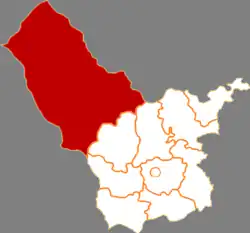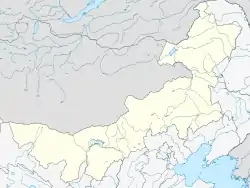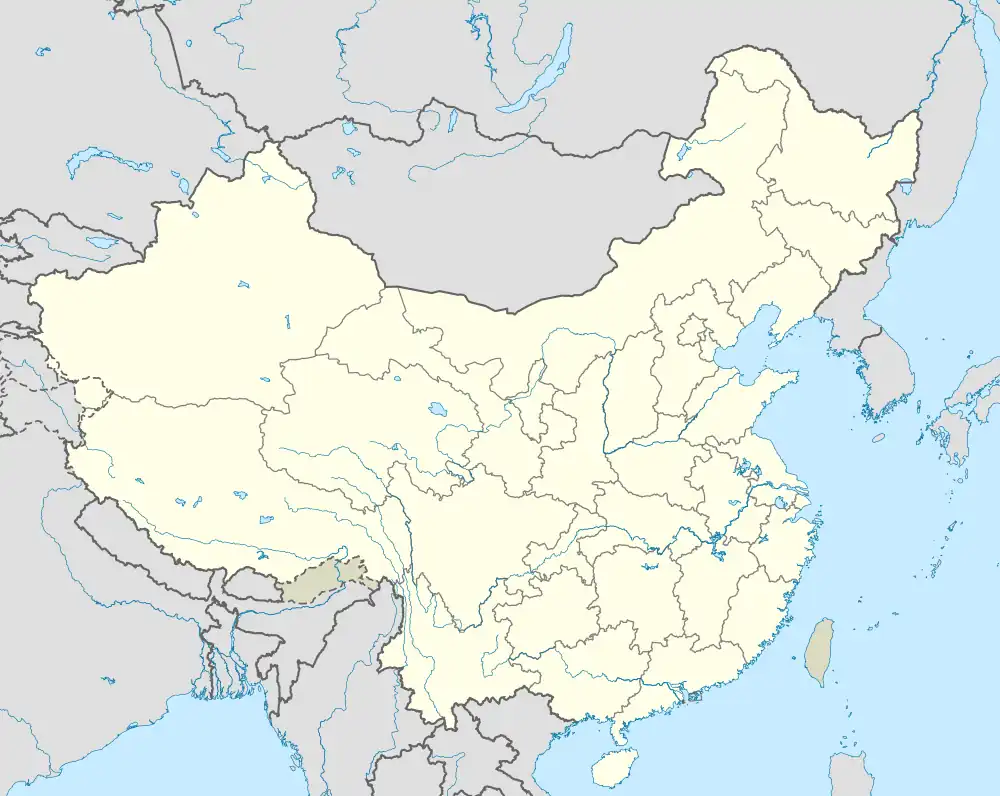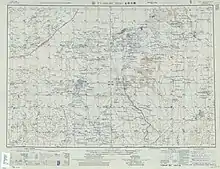Dorbod Banner
四子王旗 · ᠳᠥᠷᠪᠡᠳ ᠬᠣᠰᠢᠭᠤ Siziwang | |
|---|---|
 | |
 Dorbod in Ulanqab | |
.svg.png.webp) Ulanqab in Inner Mongolia | |
 Dorbod Location in Inner Mongolia  Dorbod Dorbod (China) | |
| Coordinates: 41°31′59″N 111°42′24″E / 41.53306°N 111.70667°E | |
| Country | China |
| Autonomous region | Inner Mongolia |
| Prefecture-level city | Ulanqab |
| Banner seat | Ulan Hua |
| Area | |
| • Total | 25,513 km2 (9,851 sq mi) |
| Population (2020)[1] | |
| • Total | 129,372 |
| • Density | 5.1/km2 (13/sq mi) |
| Time zone | UTC+8 (China Standard) |
| Website | www |
| Dorbod Banner | |||||||
|---|---|---|---|---|---|---|---|
| Chinese name | |||||||
| Chinese | 四子王旗 | ||||||
| |||||||
| Mongolian name | |||||||
| Mongolian Cyrillic | Дөрвөд хошуу | ||||||
| Mongolian script | ᠳᠥᠷᠪᠡᠳ ᠬᠣᠰᠢᠭᠤ | ||||||
| |||||||
Dorbod Banner or Siziwang Banner (Mongolian: ᠳᠥᠷᠪᠡᠳ ᠬᠣᠰᠢᠭᠤ; Chinese: 四子王旗) is a banner (county equivalent) in Ulanqab, Inner Mongolia, China,[2] bordering Mongolia's Dornogovi Province to the northwest. It is located about 80 km (50 mi) north of Hohhot, the capital of Inner Mongolia.
The banner spans 25,513 square kilometres (9,851 sq mi), and has a population of 129,372 as of 2020.[3] Its seat of government is located in Wulanhua.[4]
Toponymy
The Chinese name for the banner siziwang, literally "four princes", derives from the area's historic rule by four brothers.[3] The Mongolian name for the banner dorbed means "of four".
History

The area of Dorbod Banner was ruled by four Mongol brothers, Sengge (Сэнгэ, Chinese: 僧格), Suonuobu (Chinese: 索諾布), Bonpo (Бумба, Chinese: 鄂木布) and Yi'erzhamu (Chinese: 伊爾扎木), who were descendants of Hasar, a brother of Genghis Khan. They led their tribe in participating in the Manchu Qing Dynasty's conquest of Ming China in the early 17th century. In recognition of their service, the Qing court made Emubu the Duoluo Commandery Prince (Chinese: 多羅郡王) in 1649 and settled their tribe in the area of modern Siziwang Banner. The title was hereditary and passed through fourteen of his descendants before the Chinese Communist Party abolished all hereditary titles in Inner Mongolia in 1949. The last prince, Sudanamuchaogeji (Chinese: 蘇達那木朝格吉), died as a private citizen in 1957. There is a sculpture of the four original princes in Wulanhua, erected in 2003.
Geography
To its east lies Sonid Right Banner, Qahar Right Rear Banner, and Qahar Right Middle Banner.[4] To its south lies Wuchuan County and Zhuozi County.[4] To its west lies Darhan Muminggan United Banner.[4] Its north is formed by a 104 kilometres (65 mi) border with Mongolia.[4]
Its seat of government, the town of Wulanhua, is located 105 kilometres (65 mi) away from Hohhot, and 270 kilometres (170 mi) away from Erlianhot.[4]
The banner is located along the northern foothills of the Yin Mountains, and has an average elevation of 1,400 metres (4,600 ft).[4] Most of the banner's area is grassland.[4]
Climate
The banner experiences an average of 250 millimetres (9.8 in) to 300 millimetres (12 in) of precipitation annually.[4] Its average annual temperature is 3 °C (37 °F).[4]
| Climate data for Dorbod Banner (1991–2020 normals, extremes 1981–2010) | |||||||||||||
|---|---|---|---|---|---|---|---|---|---|---|---|---|---|
| Month | Jan | Feb | Mar | Apr | May | Jun | Jul | Aug | Sep | Oct | Nov | Dec | Year |
| Record high °C (°F) | 8.8 (47.8) |
14.9 (58.8) |
20.9 (69.6) |
28.7 (83.7) |
32.3 (90.1) |
36.5 (97.7) |
36.9 (98.4) |
33.5 (92.3) |
32.2 (90.0) |
24.3 (75.7) |
17.9 (64.2) |
12.4 (54.3) |
36.9 (98.4) |
| Mean daily maximum °C (°F) | −6.7 (19.9) |
−2.3 (27.9) |
4.9 (40.8) |
13.5 (56.3) |
20.0 (68.0) |
24.8 (76.6) |
26.9 (80.4) |
24.9 (76.8) |
19.7 (67.5) |
12.0 (53.6) |
2.6 (36.7) |
−5.0 (23.0) |
11.3 (52.3) |
| Daily mean °C (°F) | −14.3 (6.3) |
−9.9 (14.2) |
−2.2 (28.0) |
6.3 (43.3) |
13.2 (55.8) |
18.3 (64.9) |
20.7 (69.3) |
18.5 (65.3) |
12.8 (55.0) |
5.0 (41.0) |
−4.2 (24.4) |
−11.8 (10.8) |
4.4 (39.9) |
| Mean daily minimum °C (°F) | −19.9 (−3.8) |
−15.7 (3.7) |
−8.2 (17.2) |
−0.4 (31.3) |
6.2 (43.2) |
11.7 (53.1) |
14.7 (58.5) |
12.6 (54.7) |
7.0 (44.6) |
−0.4 (31.3) |
−9.1 (15.6) |
−16.9 (1.6) |
−1.5 (29.3) |
| Record low °C (°F) | −34.2 (−29.6) |
−30.8 (−23.4) |
−27.7 (−17.9) |
−15.0 (5.0) |
−7.4 (18.7) |
0.5 (32.9) |
6.4 (43.5) |
1.9 (35.4) |
−5.4 (22.3) |
−14.1 (6.6) |
−27.1 (−16.8) |
−32.7 (−26.9) |
−34.2 (−29.6) |
| Average precipitation mm (inches) | 3.5 (0.14) |
4.5 (0.18) |
7.9 (0.31) |
13.0 (0.51) |
29.9 (1.18) |
44.5 (1.75) |
81.8 (3.22) |
63.6 (2.50) |
43.7 (1.72) |
18.7 (0.74) |
7.7 (0.30) |
4.3 (0.17) |
323.1 (12.72) |
| Average precipitation days (≥ 0.1 mm) | 5.4 | 4.9 | 5.7 | 5.0 | 6.8 | 11.1 | 11.4 | 11.1 | 9.0 | 5.4 | 5.8 | 6.1 | 87.7 |
| Average snowy days | 8.7 | 7.2 | 7.3 | 3.7 | 1.0 | 0 | 0 | 0 | 0.3 | 3.1 | 7.4 | 9.0 | 47.7 |
| Average relative humidity (%) | 59 | 53 | 43 | 35 | 37 | 46 | 57 | 60 | 56 | 52 | 55 | 58 | 51 |
| Mean monthly sunshine hours | 212.9 | 213.6 | 260.0 | 275.4 | 304.1 | 284.7 | 298.9 | 288.0 | 255.4 | 250.6 | 209.1 | 197.9 | 3,050.6 |
| Percent possible sunshine | 72 | 71 | 70 | 69 | 67 | 63 | 66 | 68 | 69 | 74 | 72 | 70 | 69 |
| Source: China Meteorological Administration[5][6] | |||||||||||||
Administrative divisions
Dorbod Banner is divided into 5 towns, 3 townships, and 5 sums.[7]
| Name | Simplified Chinese | Hanyu Pinyin | Mongolian (Hudum Script) | Mongolian (Cyrillic) | Administrative division code |
|---|---|---|---|---|---|
| Towns | |||||
| Ulan Hua Town | 乌兰花镇 | Wūlánhuā Zhèn | ᠤᠯᠠᠭᠠᠨᠬᠤᠸᠠ ᠪᠠᠯᠭᠠᠰᠤ | Улаанухаа балгас | 150929100 |
| Jishengtai Town | 吉生太镇 | Jíshēngtài Zhèn | ᠵᠢᠢ ᠱᠧᠩ ᠲᠠᠢ ᠪᠠᠯᠭᠠᠰᠤ | Жий шинтэй балгас | 150929101 |
| Huret Town | 库伦图镇 | Kùlúntú Zhèn | ᠬᠦᠷᠢᠶᠡᠲᠦ ᠪᠠᠯᠭᠠᠰᠤ | Хүрээт балгас | 150929102 |
| Gongjitang Town | 供济堂镇 | Gōngjìtáng Zhèn | ᠭᠦᠩ ᠵᠢᠢ ᠲᠠᠩ ᠪᠠᠯᠭᠠᠰᠤ | Хүн жий даан балгас | 150929103 |
| Bayan Qogt Town | 白音朝克图镇 | Báiyīncháokètú Zhèn | ᠪᠠᠶᠠᠨᠴᠣᠭᠲᠤ ᠪᠠᠯᠭᠠᠰᠤ | Баянцогт балгас | 150929104 |
| Townships | |||||
| Dongbahao Township | 东八号乡 | Dōngbāhào Xiāng | ᠳ᠋ᠦᠩ ᠪᠠ ᠬᠣᠤ ᠰᠢᠶᠠᠩ | Дүн ба хоо шиян | 150929204 |
| Hujirt Township | 忽鸡图乡 | Hūjītú Xiāng | ᠬᠤᠵᠢᠷᠲᠤ ᠰᠢᠶᠠᠩ | Хужирт шиян | 150929205 |
| Daheihe Township | 大黑河乡 | Dàhēihé Xiāng | ᠳ᠋ᠠ ᠾᠧᠢ ᠾᠧ ᠰᠢᠶᠠᠩ | Да гей ге шиян | 150929206 |
| Sums | |||||
| Honggor Sum | 红格尔苏木 | Hónggé'ěr Sūmù | ᠬᠣᠩᠭᠣᠷ ᠰᠤᠮᠤ | Хонгор сум | 150929200 |
| Janggan Sum | 江岸苏木 | Jiāng'àn Sūmù | ᠵᠠᠩᠭᠠᠨ ᠰᠤᠮᠤ | Зангаа сум | 150929201 |
| Qagan Bulag Sum | 查干补力格苏木 | Chágànbǔlìgé Sūmù | ᠴᠠᠭᠠᠨᠪᠤᠯᠠᠭ ᠰᠤᠮᠤ | Цагаанбулаг сум | 150929202 |
| Nomgan Sum | 脑木更苏木 | Nǎomùgèng Sūmù | ᠨᠣᠮᠣᠭᠠᠨ ᠰᠤᠮᠤ | Номгон сум | 150929203 |
| Bayan Obo Sum | 巴音敖包苏木 | Bāyīn'áobāo Sūmù | ᠪᠠᠶᠠᠨᠣ᠋ᠪᠣᠭᠠ ᠰᠤᠮᠤ | Баянөваа сум | 150929207 |
Other: Ulan Pasture (乌兰牧场)
Demographics
As of 2009, the banner is home to 216,990 people, up from the 180,568 reported in the 2000 Census.[3]
The banner's ethnic minorities include 18,902 Mongols (8.71% of the total population), 1,086 Manchus (0.50%), and 837 Hui people (0.39%).[3]
Economy
Mineral deposits in the banner include gold, copper, nickel, manganese, fluorite, gypsum, coal, and thenardite.[4]
Spacecraft landing site
The banner served as the landing sites for China's Shenzhou program.[8]
A pasture known as Amugulang, located in Honggor Sum, about 60 km (37 mi) north of Wulanhua, served as the landing site for the Shenzhou-6 spacecraft.[9] A specially constructed 64.69 km (40.20 mi) road runs from Wulanhua to Honggor to aid the recovery of the Shenzhou spacecraft, and to boost the local economy.[9] This road shortened the journey between the two towns from two hours to just 40 minutes.[9]
Chinese space program recovery teams (with SUV and recovery trucks) track the progress of re-entry near the landing site and arrive shortly after landing.[10]
A small recovery trucks fitted with a crane lifts the capsule and places it on the rear of the truck for transportation back to the space centre.
Since the final landing of Shenzhou 11 in Dorbod Banner in 2016, new facilities have been built to hasten the retrieval process for various spacecraft.
In December 2020, the Chang'e 5 spacecraft landed in Dorbod Banner following a successful collection of Moon rocks.[8]
See also
Notes
- ^ — All of the names presented here are transcribed from Chinese language sources using Hanyu Pinyin into the Roman alphabet. However, as these names are Mongolian and/or Manchu in origin, it would be much more accurate to transcribe them directly from those languages. These transcriptions are, however, unavailable as of now.
References
- ↑ Inner Mongolia: Prefectures, Cities, Districts and Counties
- ↑ 2020年统计用区划代码(乌兰察布市) (in Chinese). National Bureau of Statistics of China. 2020. Archived from the original on 2020-12-17. Retrieved 2020-12-17.
- 1 2 3 4 四子王旗历史沿革. xzqh.org (in Chinese). 2013-04-16. Archived from the original on 2020-12-17. Retrieved 2020-12-17.
- 1 2 3 4 5 6 7 8 9 10 11 四子王旗概况地图. xzqh.org (in Chinese). 2013-04-16. Archived from the original on 2020-12-17. Retrieved 2020-12-17.
- ↑ 中国气象数据网 – WeatherBk Data (in Simplified Chinese). China Meteorological Administration. Retrieved 10 October 2023.
- ↑ 中国气象数据网 (in Simplified Chinese). China Meteorological Administration. Retrieved 10 October 2023.
- ↑ 2022年统计用区划代码(四子王旗) (in Chinese). National Bureau of Statistics of China. 2022.
- 1 2 "Chinese Capsule Returns to Earth Carrying Moon Rocks". Time. 2020-12-16. Archived from the original on 2020-12-17. Retrieved 2020-12-17.
- 1 2 3 "People's Daily Online -- Primary landing site ready to greet Chinese taikonauts back home". people.cn. 2005-10-15. Archived from the original on 2020-12-18. Retrieved 2020-12-18.
- ↑ Shenzhou 5 Archived 2011-06-28 at the Wayback Machine